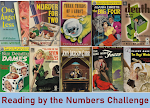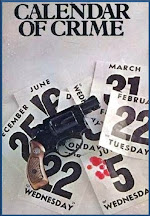 Meat for Murder (1943) is the second mystery I've read by Lange Lewis (Jane Lewis Brandt, 1915 - 2003) and like The Birthday Murder it is set in the world of Hollywood. This time around, we have Earl Falconer, eccentric Hollywood scene designer who lives in a remote house in the hills near Tinsel Town. The house looks like a castle, complete with moat and non-functioning drawbridge (permanently in the down position). Falconer lives here with two body guards, three dogs (a Great Dane and two Dalmatians), a highly religious cook, and a French mathematician who has suffered a nervous breakdown.
Meat for Murder (1943) is the second mystery I've read by Lange Lewis (Jane Lewis Brandt, 1915 - 2003) and like The Birthday Murder it is set in the world of Hollywood. This time around, we have Earl Falconer, eccentric Hollywood scene designer who lives in a remote house in the hills near Tinsel Town. The house looks like a castle, complete with moat and non-functioning drawbridge (permanently in the down position). Falconer lives here with two body guards, three dogs (a Great Dane and two Dalmatians), a highly religious cook, and a French mathematician who has suffered a nervous breakdown.Falconer hires three English majors to come live with him and write a movie script based on his set designs and vague plot ideas. They will get paid if they agree to live in the house for the duration of the writing period and IF he thinks the work worthwhile when they finish (sounds an awful lot like a certain candidate for President...). Also running in and out of his life are a few females with which he's been entangled and another set of writers whose work was deemed insufficient and who are threatening to sue him. Falconer also has set ideas on how the folks in his house should behave--he's anti-meat, anti-drinking, and anti-smoking. He's not exactly making friends and influencing people so when he winds up dead from arsenic poisoning, Lieutenant Tuck doesn't have to look far for motives. Except...it looks like someone also tried to poison Denise Morrissey, one of the ladies intent on marrying him, and has successfully poisoned all three of his dogs as well. Who has a grudge big enough to kill three animals and attempt another murder while doing away with Falconer? Once Tuck solves the mystery of the extra poisonings, he'll be well on his way to solving Falconer's murder.
This is a decent mystery overall with a good healthy dose of misdirection and red herrings to keep the reader occupied. The characterization is fairly well done--best with Falconer, the writers and Andre, the mathematician. Tom and Jim, the two bodyguards, were pretty generic and interchangeable and I had a hard time keeping Falconer's lady friends straight in my mind. (Now which one was it who got poisoned?) But the story chugged along at a good rate up till then end...and then it sort of coughed to a halt. I'm not sold on the solution--either for the main poisoning or the explanation for what happened to the dogs. It seemed a bit rushed and like Lewis hadn't quite settled how to wrap things up before she found herself needing to do so. A good solid ★★★ effort for about 95% of the book....
**********
This fulfills the "Dog" category on the Golden Vintage Scavenger Hunt card.






































